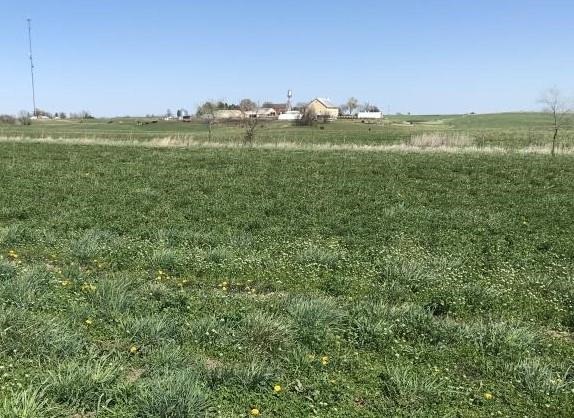By Meaghan Anderson and Bob Hartzler
Fall is one of the best times for managing perennial and biennial weeds found in pastures or other areas maintained in perennial grass. As perennials prepare for the upcoming winter, they move energy reserves from shoots to their perennial vegetative reproductive structures (e.g. rhizomes, perennial rootstocks). Systemic herbicides applied at this time are translocated along with the energy reserves to the reproductive structures, therefore providing more consistent control than applications made at most other times of the year. The warmer than typical fall this year may offer a larger window of opportunity for these applications prior to winter.
 Controlling weeds in pastures increases the quality of forage available for animals.
Controlling weeds in pastures increases the quality of forage available for animals.The majority of herbicides used in pastures are growth regulator herbicides (Group 4)1. While products containing picloram (Tordon, Grazon P+D, etc.) and aminopyralid (Milestone, Forefront, Grazon Next HL, etc.) typically cost more than the ‘traditional’ pasture treatment of 2,4-D and dicamba, they generally provide better long-term control of perennials like Canada thistle. Products containing metsulfuron-methyl (Group 2; Escort XP) provide an alternative to the growth regulators.
The following are important considerations before making any applications:
- Scout the area to determine target weeds, their location, and the physical condition of their foliage.
- While some fields may require a broadcast application, targeted treatments may be sufficient in others. Perennial weeds such as Canada thistle usually are found in distinct patches that facilitate spot treatments.
- For effective control, weeds must have healthy foliage capable of absorbing and translocating herbicide to the roots. If extensive leaf damage is evident on the weeds, reduced herbicide absorption may diminish herbicide activity.
- While much of the state has been in drought this summer, most areas have received sufficient rainfall and cooler temperatures to allow recovery. Pasture species suffering from drought may be more susceptible to injury from herbicide applications.
- Read herbicide labels carefully to determine weeds controlled, appropriate rates, and any restrictions for treated areas. Residues of certain products (picloram, clopyralid, aminopyralid) persist in the foliage of plants in treated areas and can be moved with forage or in waste (i.e. manure) of animals consuming the forage. The herbicide residues can damage sensitive plants if moved from the application area with forage or livestock.
- Herbicide treatment will control legumes that have been interseeded with the grass.
- Herbicide applications can still be effective after a frost if the foliage of the weeds is still active. Make applications on days with sunny conditions and daytime temperatures above 50-55 F whenever possible. Read more in this article “Effect of frost on pasture weed control.”
 Foliage of weeds must be in good condition to obtain effective control.
Foliage of weeds must be in good condition to obtain effective control.Rather than simply applying a herbicide to eliminate weed problems in pastures, take time to determine why the weeds are successful in the field. A healthy sod should be able to prevent the establishment of most weeds. Evaluate soil fertility, stocking rates, and determine the need for overseeding to thicken the grass. Herbicides are valuable tools for improving pasture quality, but they are not a substitute for good management practices.
Source : iastate.edu